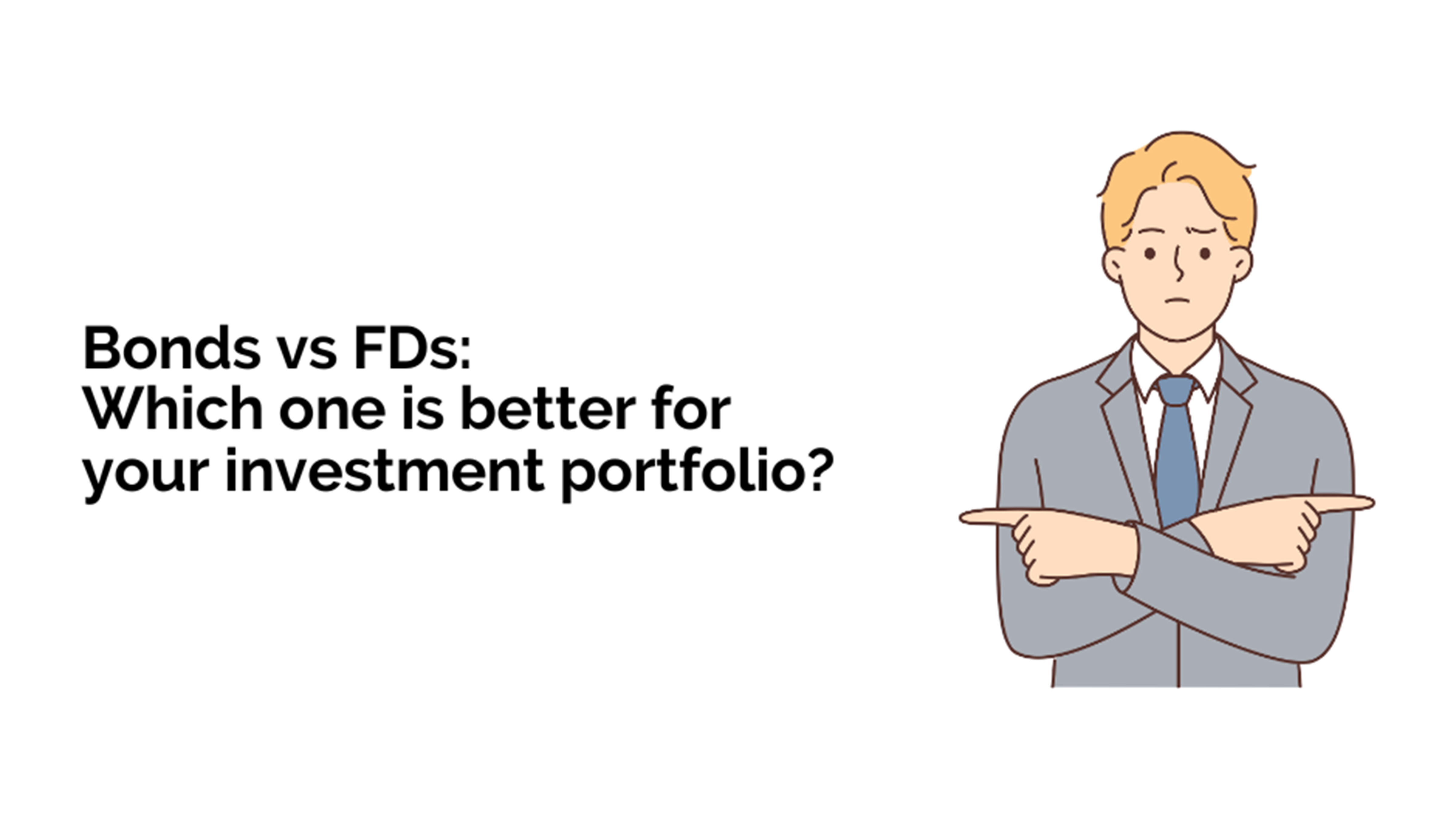Bonds vs FDs Which one is better for your investment portfolio

Bonds vs FDs: Which one is better for your investment portfolio?
Over the years, you would have observed your parents investing in bank or post-office fixed deposits (FDs) to park their savings. For decades, until the 2000s, FDs were the popular kids in the investment class. The reason? Well, there are two: i) FDs used to satisfy the need of investors with stable returns, and it was convenient ii) there was a lack of awareness to choose any other investment options like bonds even as they fall under the same category of fixed-income instruments.
However, the time has changed, and FDs or post office deposits no longer provide inflation-beating returns. In such times, it is crucial for you to move on from FDs and explore other options, such as bonds. Bonds are similar to FDs in a way that they add stability to your portfolio, but if we compare, bonds are far better compared to FDs. How? Well, let’s find out after clearing some basics.
Bonds vs. FDs: Clear the basics
A bond is a fixed-income instrument in which, as an investor, you are lending money to the issuer of the bond in return for interest income at the time of maturity, along with the principal amount. Bonds are issued by central and state governments, municipalities, and private companies and are typically backed by a physical asset.
On the other hand, a fixed deposit is a deposited amount in public/private banks, NBFCs, or post offices. You earn interest on your investment term and receive the principal + interest
amount of maturity. FDs are considered a safe investment option, but they are not backed by physical assets like bonds.
In comparison, bonds provide higher returns than FDs. However, bonds are also considered risky compared to FDs. The average return on bonds ranges from 7% to 9%, while for FDs, it is around 5% to 6.50%. The question is, why should you tilt towards bonds over FDs?
The ins and outs of FDs vs. Bonds: Which one is better?
The main reason that investors used to invest in FD in earlier times was that they thought it was the only safe haven as they didn't understand bonds. However, the time has changed and when we compare bonds with FDs, they are not only safe options but also superior in many ways.
Return on FDs vs bonds
FDs and bonds both provide fixed interest returns for the tenure of investment. However, unlike FDs, you also get capital gains by investing in bonds as the price of bonds increases over a period of time.
Additionally, since the ’80s and ’90s, interest rates on FDs have been on a constant decline; this is not the case with bonds. If you see the current rates, the interest on FDs is hardly 5% to 6%, against 11% to 13% in the 80s and ’90s. In comparison, bonds, depending on the categories, have provided an average return of 8% to 11%. Not to forget that, along with this fixed interest, you also receive appreciation in the prices of bonds with time.
Taxation on FDs vs bonds
The interest income you earn on fixed deposits is added to your income tax slab. If interest income goes above Rs. 40,000 for a financial year, you need to pay 10% TDS if you procure a PAN card. Otherwise, it is 20%. This can be daunting as FD returns are already lower, and higher taxes can lead to you not gaining any real gains.
While you also pay taxes with bonds, they are much more efficient. The interest earned on bonds is as per your tax bracket, but not the capital gains. The capital gains can be short and long-term based on which type of bonds you invest in, their duration, and where you sell them. STCG is applicable as per the tax slab, and LTCG for listed and unlisted bonds are 10% and 20%, respectively.
Also, unlike FDs, where you only have the option of tax-free FDs, there are a variety of bonds that offer you avenues to reduce your tax liabilities. For example, tax-free bonds, tax-saving bonds, government-issued infrastructure bonds, sovereign gold bonds, 54EC bonds, etc. If you plan your bond investment well, you can get tax deductions and tax-free income as well (depending on the bond category).
Lock-in period of the interest rate for FDs vs bonds
With fixed deposits, you can lock in your interest return for a maximum of 7 to 10 years. Additionally, the interest reduces as the tenure of investment increases. Compared to that, bonds offer you to lock in your interest rate for a much extended period of up to 40 years. There are also some instances of 100-year bonds. Bonds are much more flexible; you can invest from a 1-month to literally years and can lock in interest rates. This is not the case with FDs, as the most efficient tenure for maximum return is 5 years.
This feature of bonds proves to be a boon during the time of reducing interest rates by the central bank. FD rates tend to reduce during this period. In contrast, long-term bond yield (interest rate) becomes more attractive. Also, there is no reinvestment risk for bonds like there exists for FDs.
The bottom line
For investments, it is crucial to find the perfect option to ensure that your money is not decaying with time. Bonds and FDs both have their own advantages. However, in terms of return, tax efficiency, and flexibility to lock in interest rates, bonds outgrow FDs.
